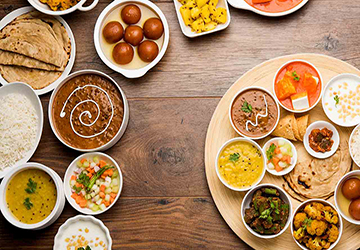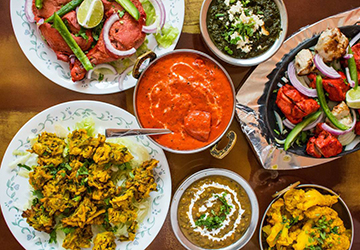India, a diverse and culturally rich nation, is celebrated for many things. But nothing is as integral to its identity as its cuisine. With a history that goes back thousands of years, Indian food is a testament to the nation's love for vibrant flavors, rich aromas, and diverse culinary traditions. In this Indian food guide, we'll dive deep into the heart of Indian cooking and discover the importance of spices in Indian cuisine, the magic of curry and masala, and some cherished traditional Indian recipes.
Indian cuisine is unimaginable without its array of spices. These aren't just about adding heat to the dish; they balance flavors, medicinal benefits, and an explosion of aromas. Some essential herbs include turmeric (known for its anti-inflammatory properties), cardamom, cloves, and cumin. But how these spices are used brings out the best in every dish.
For instance, a tadka (tempering) with mustard seeds and curry leaves can transform a simple lentil soup into a rich and flavorful dal. Fenugreek leaves can turn a curry from bland to fragrant in seconds. Indeed, the spices in Indian cuisine are not just ingredients but the very essence of the dish.

When people outside India hear "curry," they often think of a thick, spicy sauce. But in reality, curry and masala signify much more in Indian cooking. A curry can be watery, dry, red, green, hot, or mild. It's a generic term used to describe a dish with gravy. The term "masala," on the other hand, refers to a blend of spices. This blend can be dry or in paste form, and each region in India has its signature masala.
For example, garam masala from the North is a fragrant mix of warming spices like cloves, cinnamon, and cardamom, while the panch phoran from Bengal consists of five seeds. The mastery lies in understanding how and when to use each curry and masala, giving each dish its distinct character.
India's vast landscape is home to many traditional Indian recipes, each narrating a unique story of its origin. From the rich butter chicken of Punjab to the tangy fish curries of Kerala, every dish reflects the region's history, climate, and culture.
Biryani, for example, is a layered rice dish believed to have Persian origins. Cooked with fragrant basmati rice, tender meat, and a blend of spices, it's a favorite across the country. Similarly, the sambar of South India is a tangy lentil stew enriched with vegetables and tamarind, representing the region's penchant for balanced and nutritious meals.
India is a subcontinent, and each of its regions brings a different culinary tradition to the table:
● Northern India: Known for its tandoori and Mughlai dishes. Think of creamy butter chicken, fluffy naan bread, and robust chole (chickpea curry).
● Eastern India: Famous for its fish curries, rice dishes, and sweets like rasgulla and sandesh.
● Southern India: Home to dosas, vadas, and tangy tamarind rice. Coconut and tamarind are the dominant flavors here.
● Western India: A mix of everything! From the fiery curries of Rajasthan to the poha of Madhya Pradesh and the seafood delights of Goa.
This regional diversity ensures the Indian food guide never lacks flavors and techniques to explore.
No discussion of Indian food would be complete without mentioning its vibrant street food culture. Every state, city, and even neighborhood might have its signature snack. Here are a few must-tries:
● Pani Puri: Hollow puris filled with spicy tamarind water, chickpeas, and potatoes.
● Vada Pav: Mumbai's answer to the burger. A spiced potato patty is placed inside a bun and served with chutneys.
● Kathi Rolls: Skewer-roasted kebabs wrapped in parathas with sauces and salads.
● Dhokla: A steamed, fermented rice and chickpea flour cake from Gujarat.
Street food is a testament to India's innovation in the culinary world, adapting traditional recipes for the bustling urban environment.

India is a haven for vegetarians. While paneer (Indian cottage cheese) curries are beloved, there's an abundance of vegetable-based dishes that are both flavorful and nutritious:
● Baingan Bharta: Roasted and mashed eggplant cooked with onions, tomatoes, and spices.
● Bhindi Masala: Okra stir-fried with a mix of spices.
● Dal Makhani: A creamy lentil curry made with black lentils and kidney beans.
● Aloo Gobi: A delightful dry curry made from potatoes and cauliflower.
These dishes highlight how Indian cooking elevates the simplest ingredients to culinary masterpieces.
Indian desserts are as diverse as its spices:
● Gulab Jamun: Deep-fried balls of dough soaked in a sugar syrup.
● Jalebi: Swirls of fermented batter fried and soaked in syrup.
● Kheer: A rice pudding flavored with cardamom and garnished with nuts.
● Halwa: This can be made from ingredients like semolina, lentils, or vegetables like carrots.
Each sweet dish is a perfect end to the spicy and flavorful meals of Indian cuisine.
The allure of spices in Indian cuisine didn't escape foreign invaders and traders. The spice trade led to colonization, and the foreign influences intermingled with local traditions. Dishes like chicken tikka masala, which is immensely popular in the UK, result from this fusion. Thus, Indian cuisine is not just about age-old traditions but also about adapting and evolving with time.
This Indian food guide is just a glimpse into the vast world of Indian cuisine. From the intricate play of spices in Indian cuisine to the diverse interpretations of curry and masala and the timeless traditional Indian recipes, Indian food offers a symphony of flavors waiting to be experienced. As you embrace the spice, remember that every bite is a journey through India's rich culinary heritage. So, the next time you relish an Indian dish, know that you're not just tasting food but history, culture, and love.